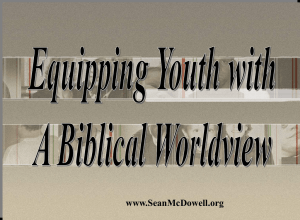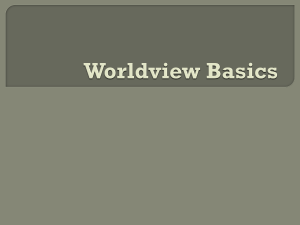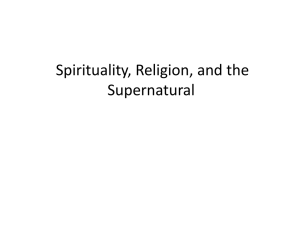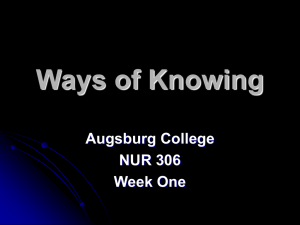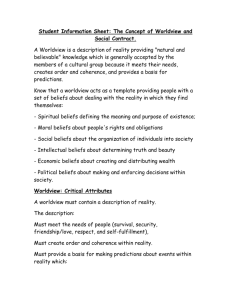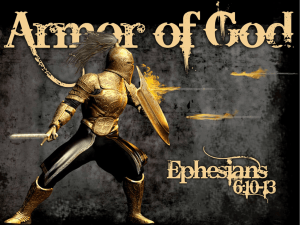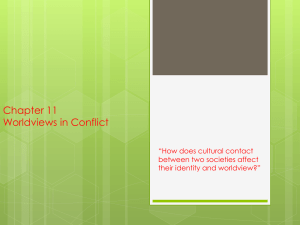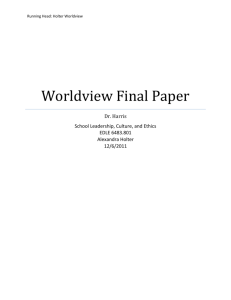Worldview: Introduction & Project Guide
advertisement
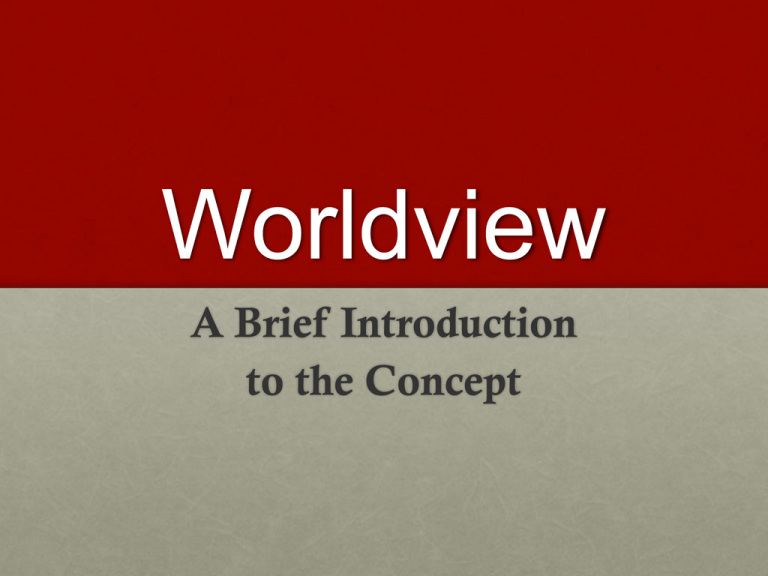
Worldview A Brief Introduction to the Concept A General Definition A “Worldview” is the comprehensive set of beliefs, knowledge, values, assumptions, attitudes, and opinions that serve as a lense through which a particular social group sees, interprets, and makes sense of the world in which it lives. One View Some Components of a Worldview • Ontology: beliefs that group members hold about the nature and reality of the physical, mental, and spiritual realms. • Epistemology: the dominant or preferred ways of knowing among most of the group’s members • Theology: the group’s beliefs about the nature of god(s), its powers, and its role in human life • Cosmology: the group’s beliefs about the origins, the nature, the history, and the future directions of the universe, as well as the place of humans within that scheme • Values: goup beliefs about what is important in life, what is to persued, obtained, protected, cherished • Ethics: group beliefs about right and wrong or good and bad behavior. Rigoberta Menchú What insights did Rigoberta Menchú provide us into the worldview of K'iche’Mayan people living in the highlands of Guatemala? Culture: A related concept Worldview Culture Culture Worldview Culture: A related concept Worldview Beliefs Values Assumptions Attitudes Culture Patterns in how people live. The Worldview Project I. Form a 4 or 5-person team II. Select a group to explore III. Conduct research IV. Prepare a multimedia PowerPoint presentation V. Deliver the presentation to the class Selecting a Group to Study • Select a “living” group whose worldview is held by real people today. • Choose a group whose worldview is different than those held by your group members. • Select a group in which all of your team members have some degree of genuine interest. • Take your time in considering the alternatives until consensus is reached. • Consult with me before making your final decision. Selecting a Group to Study Indigenous Culture Groups • Maya of Guatemala • Inuit of Alaska or the Arctic • Hutu, Tutsi, or Maasai of Africa • Maori of New Zealand • Romani or Roma (Gypsies) of central Europe • Asmat of Papua New Guinea • Mixtec or Zapotec of Oaxaca, Mexico Selecting a Group to Study Religious Groups (In which “religion”has a profound influence on its members’ belief system and lifestyle.) • Hasidic Judaism • Amish • Radical Islam • The Unification Church (Moonies) • Hare Krishnas • Wicca Selecting a Group to Study Spiritual Movement Groups • New Age • Falun Gong • Kabbalah • Scientology Focus of Your Research and Presentation A. Background and Context 1. Provide a very brief historical sketch for the group. 2. Map the place or places in the world where the group resides. 3. Show what members of the group look like. 4. Provide some demographic information on the group. Focus of Your Research and Presentation B. Key Beliefs that Comprise the Group’s Worldview • Ontological beliefs • Epistemological beliefs • Religious or spiritual beliefs • Ethical teachings • Core values • Social beliefs • Beliefs about the group’s relationship to the larger • society. Other elements necessary to understand the group’s worldview Focus of Your Research and Presentation C. Cultural Patterns Are there any cultural patterns that characterize the group and help to understand it? Rural-agrarian or urban-industrial Poverty or wealth Low formal education or high formal education Minority status or majority status History of being oppressed or oppressing others Segregated from or integrated within the wider society Other factors Focus of Your Research and Presentation D. Current Concerns, Issues, and Challenges The world is in the process of widespread and rapid change, and all worldviews are faced with the challenges of advocating for, accepting, adapting to, incorporating, resisting, or rejecting these changes, or some combination of these responses. How is your group dealing with these challenges? What are their concerns? What events or developments or pressures have their attention? How are they responding? Focus of Your Research and Presentation E. E-Bibliography Conclude your Power Point presentation with an electronic bibliography of at least 10 reseources that you feel are helpful in understanding this group and its worldview. At least some of these bibliographic resources should be ones that were created or produced by persons who were or are, themselves, members of the group you have studied. Presentation Guidelines • Your group will have 30 minutes for your presentation. • All group members should play a meaningful role in delivering your presentation. • Have the organization and flow of your presentation well planned in advance. • When speaking, make good eye contact with your audience. Try not to “read” from notes or from slides. Multimedia Presentation Oral lectures PowerPoint slides Visual images Videos Music Web sites Charts, graphs, maps Artifacts or objects Relevant Dates Group Work Time • April 03 • April 15 • April 24 Presentations
